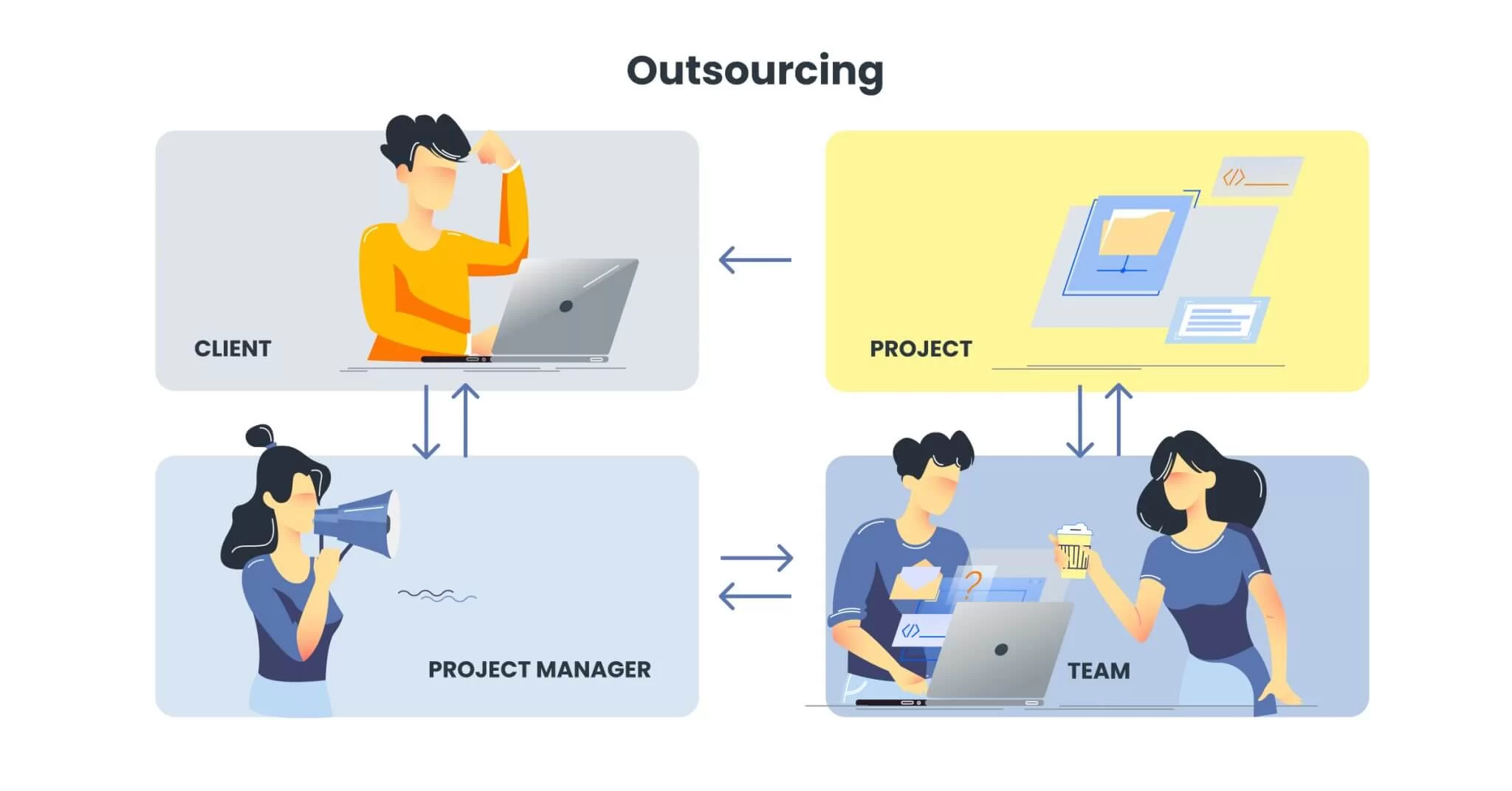Are you experiencing a time in your business development path like you feel that you are at a crossroads - Outstaffing or Outsourcing - which way to step for? This can be a scary time, but it can be an exciting one. If you are feeling like you are at crosswords, don’t worry you are not alone.

If you are still here, reading these sentences, it means you are looking to find some valuable answers to your questions and I will try to help you with this.
Business model concept
First of all let’s clarify what does “Outsourcing” and “Outstaffing” mean , as these both concepts are often confused.
“Outsourcing” is a business model in which services or job functions are hired out to a third party on a contract or ongoing basis. In other words, you hire an outside firm to develop IT products due to lack of skills in your company or you need more IT development needs than your current staff can handle.

“Outstaffing” is a type of remote recruiting model in which a vendor provides a specialist or a group of professionals for a client’s project during the contract term, meaning extending the capabilities of your IT staff.

Key differences between outstaffing and outsourcing
It's important to note that the choice between outstaffing and outsourcing depends on factors like the nature of the project, the level of control desired, the availability of talent, and the specific goals of your business and I would like to present the core distinctions in the table below, as it is crucial in making informed decisions and effectively managing resources.
Control and management
In outsourcing, the client company relinquishes a certain level of control and management to the service provider. The service provider assumes responsibility for managing the outsourced tasks or projects, including the allocation of resources and decision-making.
With outstaffing, the client company retains a higher level of control and management over the team and project execution. The client has direct oversight of the team's work, sets goals, and makes decisions.
Relationship dynamics
Outsourcing engagements can vary in duration and scope, ranging from short-term projects to ongoing partnerships. The relationship between the client company and the outsourcing provider is often more transactional and project-focused.
Outstaffing typically involves a long-term relationship between the client company and the outstaffing provider. The outstaffing team becomes integrated into the client's organization, fostering a closer working relationship.
Flexibility and scalability
Outsourcing provides flexibility and scalability as well. Companies can engage outsourcing providers for specific projects or functions, scaling up or down as needed without long-term commitments.
Outstaffing offers greater flexibility and scalability. Companies can quickly adjust the size of their outstaffed teams based on project needs or business requirements, allowing for efficient resource allocation.
Cost structure
Outsourcing costs can vary based on factors such as project scope, duration, and the pricing structure of the service provider. The costs can be project-based, hourly rates, or other arrangements.
In outstaffing, the client typically pays a fixed monthly fee or a predetermined rate for the services of the outstaffed team. The costs are often more transparent and predictable.
Team integration and cultural fit
Outsourcing may operate independently, which can require effective communication strategies and efforts to ensure cultural alignment and cohesive collaboration.
Outstaffing allows for better team integration, as the outstaffed team becomes part of the client company's culture and operations. This enables closer collaboration and alignment with the client's objectives.
Benefits and drawbacks
Both outstaffing and outsourcing has become increasingly popular in recent years as businesses attempt to do more with less.
Forbes describes quite well what kind of issues solve these business models: “There are many differences between outsourcing and outstaffing, but only one common feature: both aim to minimize financial and personnel costs and risks for the client company. For example, outsourcing is ideal when you lack the resources to quickly solve a secondary task, but if an insured event occurs, or a key employee quits and you have to find an urgent replacement — an outstaffer company handles those problems.”
Despite the advantages, you don’t go down this way until you compare to the potential disadvantages.
The following illustration summarizes the advantages and disadvantages of the two models in comparison with in-house recruitment:

Now let’s answer the following question: what are your specific business needs?
Here are some tips to help you make the right choice.
1. Assess Your Ongoing Project Requirements and Scope
Evaluate the specific requirements and scope of the project or function that needs to be outsourced or outstaffed. Do you need long-term support for existing project or developers to work on a one-time project? Outstaffing provides stable long-term support, while outsourcing is suitable for a specific project.
2. Level of control and management
Determine the level of control and management that the business wants to maintain over the tasks or functions being outsourced. If retaining direct control is crucial, outstaffing may be a more suitable option.
3. Consider In-House Expertise
If you lack technical capabilities and cannot manage a team of developers, outsourcing is the better option. However, if you have an in-house IT manager and established software processes, outstaffing is a good way to enhance your team with skilled specialists.
4. Evaluate Budget And Time
IT outstaffing services can save money for established companies because you manage the outstaffed developers. On the other hand, outsourcing costs more because the vendor manages the day-to-day operations. Outsourcing is a better choice if you have tight deadlines to meet.
5. Cultural alignment
Consider the importance of cultural alignment and communication for the project or function. Evaluate whether the business prefers a closer integration and cultural alignment with the team (outstaffing) or if a more transactional relationship is acceptable (outsourcing). Consider the potential benefits of occasional face-to-face meetings or visits between the client company and the outstaffing or outsourcing provider. In-person interactions can strengthen relationships and improve communication effectiveness.
6. Risk management and legal considerations
Evaluate the risks associated with each model, including data security, intellectual property protection, legal compliance, and contractual obligations. Consider the specific risk mitigation strategies offered by outstaffing or outsourcing providers.
7. Long-term goals and strategy
Align the choice of model with the long-term goals and strategic direction of the business. Consider whether the project or function is a one-time requirement or if it aligns with the broader objectives of the business. Evaluate if the chosen model supports future growth and scalability, in this case IT outstaffing suits you best.
8. Industry-specific factors
Take into account any industry-specific considerations, regulations, or standards that may influence the choice between IT outstaffing and IT outsourcing. Certain industries may have specific requirements or restrictions that can affect the suitability of each model. Healthcare industry can meet the specific compliance and regulatory standards such as HIPAA (Health Insurance Portability and Accountability Act) in the United States.
9. Previous experience and success stories
Learn from the experiences of other businesses in similar industries or with similar project requirements. Review success stories, case studies, and testimonials to gain insights into how IT outstaffing or IT outsourcing has worked for others in similar situations. A relevant example for successful IT outstaffing story is Spotify. IT outstaffing transformed their software engineer hiring process.
Decision-making: IT Outsourcing vs IT Outstaffing
Outsourcing and outstaffing are both beneficial for businesses. Anyone looking for a long-term solution to their staffing needs, however, should consider outstaffing in my point of view.
While outsourcing may be a more cost-effective option in the short term, it’s likely not going to last forever. As your business grows and more employees are added to your payroll, you will need to hire a full-time team.
On the other hand, if you’re in need of someone who can work on an as-needed basis, however, outsourcing might be a better option.
Key takeaways
I’ve talked about the pros and cons of outstaffing and outsourcing, and now it’s time to summarize the main points discussed.
As you can see, there are many reasons to outstaff: it can save your company more money, it can expand your workforce without increasing overhead, and it helps you get access to more IT specialized expertise and skills.
But there are also some downsides: if you outsource too far beyond your core competencies, for example, you run the risk of losing control over the project and you can go far away from what makes your company special.
When considering whether or not to outsource or outstaff any aspect of your business, take into account all factors — including all risks— and make an informed decision that reflects your vision for the future.
Now that the work has gone remote, a lot of companies consider outsourcing developers to be much simpler and cheaper than hiring them in-house. Hiring remotely enables you to access a wider pool of tech talent and even reduce your hiring costs, as long as you can employ candidates from places where the cost of living is significantly lower. At the same time, the ability to work remotely is one of the most effective ways to attract and retain talented developers.
However, for a faster and smoother process, you need to employ cutting-edge technology that can help you get matched with the right prospects. At Index.dev, as Europe's leading talent network, we can help you find skilled developers, AI experts, data engineers and scientists, QAs, UI/UX designers without the pain of searching, screening, and interviewing best-fit candidates.
Tell us your requirements, and in less than two weeks, you’ll onboard a qualified full-time remote engineer at half of the cost.
Looking to hire high-performing engineers for your project? Don’t put it off any longer ->
Also read our in-depth guides for recruiting top Java, Python, Data Engineering, and Full-Stack talents.